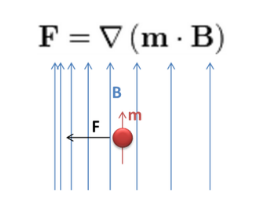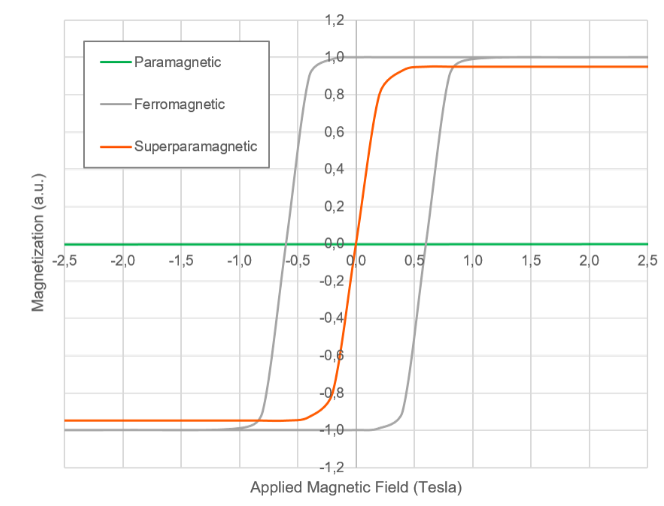Magnetic DNA or RNA purification relies on the superparamagnetic property of micro- or nano-scale particles. These particles are most often made of iron oxide, with magnetite (Fe3O4) more commonly used than maghemite (Fe2O3). Superparamagnetic particles are not innately magnetic, but they become magnetized when influenced by a magnetic field. So, if the magnetic field is zero, then the particles are not magnetic at all, but when a magnetic field is applied the particles become magnetized.

Magnetization of superparamagnetic particles
The magnetic property of a material is governed by the alignment state of its atomic dipoles. Magnetization (m) is defined as the extent to which a material becomes magnetized when placed within a magnetic field, and is a measure of the net magnetic dipole moment per unit volume. The magnetization is directly related to the applied magnetic field.
Magnetic susceptibility (χ) is a dimensionless quantity that indicates the degree of magnetization of a material in response to a magnetic field. Magnetic susceptibility is equal to the ratio of magnetic dipole moment to magnetic field.
m = magnetization (magnetic dipole moment per unit volume)
B = applied magnetic field
χ = magnetic susceptibility
χ = m / B
Non-magnetic materials, like water, are diamagnetic and experience a small negative response to the magnetic field. In the case of diamagnetic materials, the susceptibility is negative and has a value around -10e-5. Paramagnetic materials, like oxygen molecules, experience a slightly positive response to the magnetic field. In the case of paramagnetic materials, the magnetic susceptibility is around 10e-4 or 10e-5. In both cases, the magnetic dipoles attempt to align with the external magnetic field, and fight against thermal agitation. Diamagnetic and paramagnetic dipoles don’t interact with each other, and their susceptibility at room temperature is very small.
The situation is very different for magnetic materials, which are technically defined as ferro and ferrimagnetic materials. In magnetic materials, each dipole interacts with its nearest neighbors. This inter-dipole interaction creates a high magnetic response throughout the material, with susceptibilities that can reach values higher than 10e3. The drawback is that the materials show magnetic hysteresis: after applying a magnetic field, the material will have ‘memory’, meaning that when the applied field returns to zero the material remains at a certain magnetization. This is a very useful property for developing permanent magnets, but it is a problem for many Life Science applications. Ferromagnetic beads will remain magnetized after the removal of an applied magnetic field, and the beads will form irreversible clumps or aggregates.
The ideal material for biological applications would have a high magnetic susceptibility, but no magnetic ‘memory’. They would combine a high response to applied magnetic field with a non-magnetic behavior once the magnetic field is removed. Advances in nanotechnology have provided a way to obtain these superparamagnetic properties by reducing the size of the ferro- or ferrimagnetic particles to few nanometers (below the so-called superparamagnetic diameter). Then, this magnetic ‘pigment’ can be encapsulated in non-magnetic matrices such as silica, polyvinyl alcohol (PVA), dextran, agarose, sepharose, and polystyrene, which can be biofunctionalized and used for life science applications.
Superparamagnetic particles move in the direction of a magnetic field gradient
A block-shaped permanent magnet produces a magnetic field that decays with distance. A perfectly homogenous magnetic field would induce a rotation on the superparamagnetic beads, but not a displacement. A magnetized superparamagnetic bead will experience a magnetic force if it is exposed to a magnetic field that is not homogenous through space.

If the superparamagnetic particles are saturated, meaning that the magnetization (magnetic moment) is constant, then the magnetic force will be directly proportional to the magnetic field gradient. Below the saturation point the magnetic moment will vary with the magnetic field. If the superparamagnetic particles are not saturated, the magnetization is not constant, and the magnetic force will be lower and dependent upon the square of the applied field. For this reason, modern biomagnetic separation systems are engineered to ensure that superparamagnetic particles are saturated and exposed to a constant magnetic field gradient.
Reversible and irreversible aggregation
Superparamagnetic particles have a high magnetic susceptibility, and once magnetized they can interact with each other to form reversible chain-like aggregates. These chain-like aggregates improve separation time because they move faster than individual particles. Once the magnetic field is removed the particles lose the magnetic moment and the chains are dissolved by thermal fluctuations.
A second kind of aggregation can happen at the retention area. Once the magnetic beads are attracted to the final position, it is necessary to be retained with a force high enough to keep them there when the supernatant is aspirated. However, if the force is excessive, the magnetic beads would be pressed against each other, remaining irreversibly aggregated, or clumped,. This will limit the exposed surface area and change the behavior (aggregates would acts as ‘bigger’ beads), introducing both variability and inconsistency in the process.. Irreversible aggregation is a typical problem in classical magnetic separators (magnetic force decreasing sharply with distance). In these devices, increasing the force to capture the farthest beads implies a large multiplier for the retention force, and a leads to a big increase in the likelihood of irreversible aggregation problems. Modern biomagnetic separation systems avoid this problem by generating a constant force high enough to keep the magnetic beads retained when the supernatant is aspirated, but no higher. As the force is kept constant over all the working volume, the farthest beads experience a much higher force than on the classical separators, but are retained much more gently, without risk of irreversible aggregation.
Using superparamagnetic particles for nucleic acid purification
The first step in a nucleic acid purification procedure using magnetic particles is to choose a coating and functionalization strategy. While bare iron oxide particles are able to bind DNA or RNA, they are also prone to irreversible clumping. Coatings are applied to prevent unwanted clumping and also to improve adsorption of nucleic acids to the surface of the magnetic particles. Functionalization by the chemical attachment of molecular moieties makes iron oxide particles able to better adsorb nucleic acids. Control over surface functionalization also allows for specific capture of DNA or RNA.
The next step is to incubate the magnetic particles with the lysed cell solution. The nucleic acids will bind to the magnetic particles, while contaminants such as proteins and polysaccharides will not. The magnetic particle/nucleic acid conjugates are magnetized by an external magnetic field and collected at the sides of the container. The contaminating cell lysate is washed out and replaced with a clean buffer solution. The applied magnetic field is removed and the conjugates are recovered. The extracted DNA or RNA can be released from the magnetic particles by applying an appropriate buffer according to the particle’s surface chemistry.
The entire purification process can take place in a single container. No column or centrifugation is needed. The purity of the extracted genetic material is dependent on the binding efficiency and the separation efficiency. The binding efficiency is a function of the type of magnetic particle coating and chemistry used, and the separation efficiency is a function of the separation system.
Related news




